Move, 2013, Video
- Medium
- Single-channel HD colour video with sound.
- Dimensions
- Duration: 11 minutes














MOVE is a single-channel video commissioned for the Göteborg International Biennial of Contemporary Art. The film makes reference to two recent moments: the counter-cultural illegal nightclub scene in the Haga district of Göteborg during the 1980s, and the historic events that unfolded during the anti-globalisation protests in the summer of 2001 in the heart of the city. Working with cultural activist Johan Heintz, and DJ Kali (Hannes Westberg), the film explores the potency of place to connect and curtail collective action. A number of contemporary dancers were invited to interpret through improvisational movement both the recent histories of these sites and their own relationship to the public discussions these events in Sweden have engendered. Emerging from what was once an underground club, and is now a local history museum, the first dancer Anna Bergström performs on the streets in the Haga district. Once an industrial quarter of the city and a working class neighbourhood – now gentrified with coffee shops and designer craft-ware. Interacting with passers by, Anna traces the steps of the underground night-club scene. Her journey is inter-cut with footage of another dancer – Karolin Kent, whose lonely figure, crawling and dragging itself like a wounded animal, offers two perspectival views of the Hvitfeldtska School, which in 2001 saw anti- globalisation protestors barricaded by the police within the school grounds. Here, Karolin explores the bodyʼs relationship to the enormity of this site against the harsh surfaces of the car park, and the brickwork of the building. Concurrently, a troupe of dancers, led by Pia Nordin, clamber over each other, each following the otherʼs lead by wrestling and reacting to the architectural constraints of Schillerska School, the second site of police ʻkettlingʼ tactics. Inter-cut between these dance performances is the immersive and insistent rhythm of a night-club: a techno-clash of DJs and club revellers tattooed by dazzling lights against the backdrop of 1980s painted banners. Assembled together they create a psychedelic kaleidoscope of colours and conviviality that suggests an altered state of consciousness.
Related theme: Sound / Singing
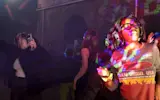
Merriment Lights
2025
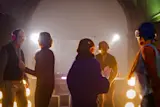
Backlit
2025
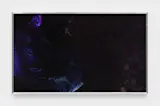
Blue jacket
2025
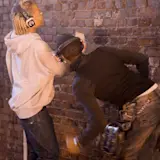
Two in motion together (Ere & Toyin)
2025

Silent Disco
2025
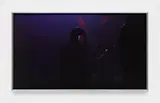
Very dark Ope
2025
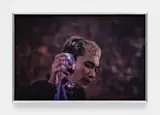
Man, glass of wine
2025

Michael & swishing braids 03
2025

Entering the Disco
2025
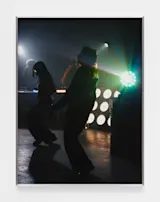
Dancers cast silhouette
2025
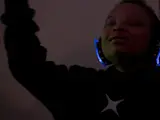
Bridie's daughter (Yewa)
2025
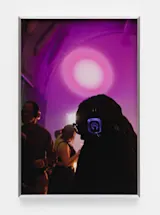
Purple Lights (Lisa)
2025
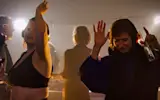
Hands up
2025
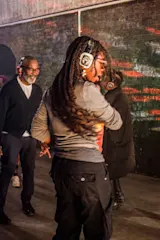
Michael & swishing braids 02
2025
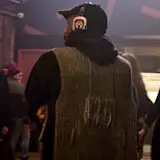
Grey Jumper
2025

Silhouette
2025

Michael & swishing braids 01
2025
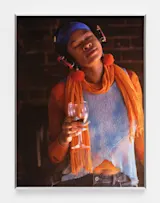
Orange scarf (Sola)
2025
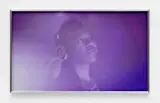
Judah
2025

Selina
2025
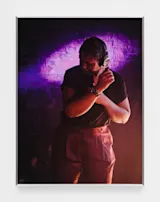
Ope
2025
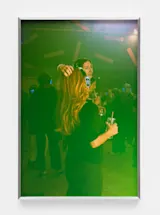
Green light (Kate)
2025
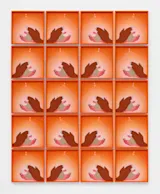
Well done
2025

BENEVOLENCE
2024

Put Your Hands Together
2024
FEELING HER WAY
2022

On My Way
2022

In the Mix: Shirley Songs
2022

In the Mix: Skunk Sputnik
2022

Ain't Misbehavin'
2022

In the Mix: Hippy Liberty
2022

In the Mix: Disciples Together
2022

In the Mix: Mel & Kim Respect
2022

In the Mix: Alexandra B’s Dress
2022

Polystyrene / X-ray Spex OH BONDAGE UP YOURS!
2021

Sheila Chandra / Ever so lonely MONSOON
2021

Miss Elizabeth Welch 1933 – 1940 / a nightingale sang in Berkeley Square
2021

Shirley Bassey / Goldfinger
2021

Sade / The Sweetest Taboo
2021

P. P. Arnold / Just call me angel of the morning
2021

Six Acts
2018

Just One Minute More
2016-2022

Exquisite Cacophony
2015

Plastic
2013

Move
2013

Is this Love That I’m Feeling?
2010

Gather:Justicia
2010

Oh Adelaide (with Ain Bailey)
2010

Taken
2009

Drift
2008

Devotional Wallpaper and Placards
2008 - 2018

For you, only you
2007

1930s to 1960s – The Rivington Place Portfolio
2006

Devotional II
2005

Devotional, 2004
2004

Lover's Rock
1998
Related theme: Performance

Merriment Lights
2025

Very dark Ope
2025

Backlit
2025

Blue jacket
2025

Man, glass of wine
2025

Michael & swishing braids 03
2025

Entering the Disco
2025

Bridie's daughter (Yewa)
2025

Dancers cast silhouette
2025

Grey Jumper
2025

Purple Lights (Lisa)
2025

Hands up
2025

Michael & swishing braids 02
2025

Ope
2025

Silent Disco
2025

Silhouette
2025

Two in motion together (Ere & Toyin)
2025

Michael & swishing braids 01
2025

Judah
2025

Orange scarf (Sola)
2025

Green light (Kate)
2025

Selina
2025

Put Your Hands Together
2024

BENEVOLENCE
2024

In the Mix: Disciples Together
2022

On My Way
2022
FEELING HER WAY
2022

In the Mix: Shirley Songs
2022

In the Mix: Skunk Sputnik
2022

Ain't Misbehavin'
2022

In the Mix: Hippy Liberty
2022

Yes, I Hear You
2022

Family Gorgeous Smudged
2022

In the Mix: Mel & Kim Respect
2022

In the Mix: Alexandra B’s Dress
2022

P. P. Arnold / Just call me angel of the morning
2021

Miss Elizabeth Welch 1933 – 1940 / a nightingale sang in Berkeley Square
2021

Sheila Chandra / Ever so lonely MONSOON
2021

Shirley Bassey / Goldfinger
2021

Sade / The Sweetest Taboo
2021

Polystyrene / X-ray Spex OH BONDAGE UP YOURS!
2021

Six Acts
2018

The Audition
1997 - printed 2018

We move in her way
2017

Just One Minute More
2016-2022

Paper Tiger Whisky Soap Theatre (Dada Nice)
2016

Exquisite Cacophony
2015

Move
2013

Dance of Belém
2011

Gather:Justicia
2010

Oh Adelaide (with Ain Bailey)
2010

Taken
2009

Devotional Wallpaper and Placards
2008 - 2018

Drift
2008

For you, only you
2007

Crop Over
2007

Exquisite Tension
2006

1930s to 1960s – The Rivington Place Portfolio
2006

Devotional II
2005

Devotional, 2004
2004
Related theme: Participatory / Collaboration

Very dark Ope
2025

Blue jacket
2025

Backlit
2025

Man, glass of wine
2025

Michael & swishing braids 03
2025

Entering the Disco
2025

Bridie's daughter (Yewa)
2025

Dancers cast silhouette
2025

Grey Jumper
2025

Silhouette
2025

Purple Lights (Lisa)
2025

Hands up
2025

Michael & swishing braids 02
2025

Judah
2025

Green light (Kate)
2025

Two in motion together (Ere & Toyin)
2025

Michael & swishing braids 01
2025

Orange scarf (Sola)
2025

Silent Disco
2025

Selina
2025

Ope
2025

Merriment Lights
2025

BENEVOLENCE
2024

Yes, I Hear You
2022
FEELING HER WAY
2022

Ain't Misbehavin'
2022

Family Gorgeous Smudged
2022

In the Castle of My Skin
2020 - 2021

The Audition in Colour
1997 - printed 2020

The Audition
1997 - printed 2018

Six Acts
2018

We move in her way
2017

Paper Tiger Whisky Soap Theatre (Dada Nice)
2016

Exquisite Cacophony
2015

Move
2013

Dance of Belém
2011

Oh Adelaide (with Ain Bailey)
2010

Gather:Justicia
2010

Taken
2009

Devotional Wallpaper and Placards
2008 - 2018

Drift
2008

Crop Over
2007

For you, only you
2007

Exquisite Tension
2006

Devotional II
2005

Devotional, 2004
2004

Tongues
1997

They're Almost Like Twins
1995

Untitled (Kiss)
1995